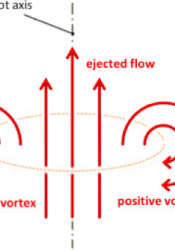Aortic Valve Experiment, Brian Bellhouse
Utilizing dyes and radiographic markers to track blood flow, Brian Bellhouse conducted a famous experiment proving correct an old rejected theory about the heart by Leonardo da Vinci. Because Da Vinci never formally published his anatomical research, scholars disregarded much of his physiological deductions for centuries. One such neglected idea was his model for blood flow in the aortic arch. By applying knowledge on fluid dynamics, Da Vinci concluded that mechanism to prevent backflow into the heart was driven by flow eddies created by blood pumped into the arch following a sinus ridge. These flow eddies then create circular vortexes that would press against aortic valves, in particular the sinuses of Valsalva, from the sides to close them at even the slightest amount of systolic backflow. Until Bellhouse’s experiment, scientists believed the mechanism involved direct pressure from above the valve, which Da Vinci believed wouldn’t work as such forces would crumple the sinuses.
Sources:
Boon, B. “Leonardo da Vinci on atherosclerosis and the function of the sinuses of Valsalva”. Netherlands Heart Journal. US National Library of Medicine, Dec. 2009. Web, 15 Feb., 2018. Link
Image Source:
Toninato, Riccardo; & Salmon, Jacob; & Susin, Francesca; & Ducci, Andrea; Burriesci, Gaetano. “Physiological vortices in the sinuses of Valsalva: An In Vitro approach for bio-prosthetic valves.” Journal of Biomechanics. Science Direct, 6 Sep. 2016. Link

